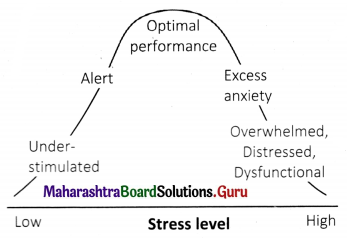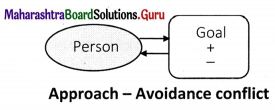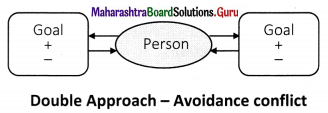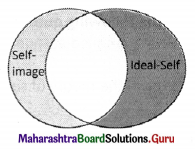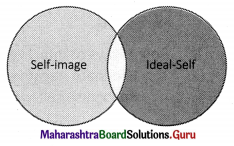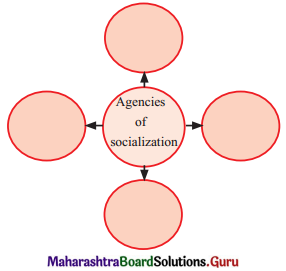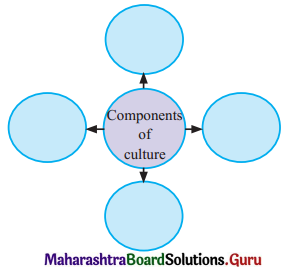Balbharti Maharashtra State Board Class 11 Psychology Solutions Chapter 5 Healthy Me – Normal Me Textbook Exercise Questions and Answers.
Maharashtra State Board Class 11 Psychology Solutions Chapter 5 Healthy Me – Normal Me
1A. Complete the following statements.
Question 1.
One of the criteria of well-adjusted behaviour is ___________
(a) intelligence
(b) openness to new experience
(c) success
(d) artistic ability
Answer:
(b) openness to new experience
Question 2.
According to the humanistic perspective, every individual strives for ___________
(a) absence of problems
(b) absence of mental disorder
(c) enjoyment in life
(d) development of one’s abilities to the fullest
Answer:
(d) development of one’s abilities to the fullest

Question 3.
According to ___________ perspective, one of the causes of abnormality is ‘genetic predisposition’.
(a) behavioural
(b) biological
(c) sociocultural
(d) cognitive
Answer:
(b) biological
Question 4.
___________ face the identity crisis.
(a) Children
(b) Adolescents
(c) Young adults
(d) Old people
Answer:
(b) Adolescents
1B. State whether the following statements are True or False and justify your answer with reason.
Question 1.
Sucheta has an IQ that falls into the category of genius which is rare to find. ‘Genius’ is statistical deviance. Therefore, she is abnormal.
Answer:
False
Reason: Although Sucheta’s IQ is statistically deviant, she does not exhibit other criteria of being abnormal such as personal distress and impaired functioning. Hence, she can’t be considered as being abnormal.
Question 2.
It is very rare to find a person possessing all the criteria of a well-adjusted person.
Answer:
True
Explanation: A well-adjusted person has 5 main criteria. Some people may show some criteria while others may be high on some other criteria.

Question 3.
Over-expectation from the parents can lead to a lack of self-confidence.
Answer:
True
Explanation: If parents expect their child to do more than what he/she is capable of, they are pushing their child too hard. It will lead to anxiety, underperformance, and consequently, low self-confidence.
Question 4.
A well-adjusted individual does not encounter failure at all.
Answer:
False
Reason: A well-adjusted individual will encounter failure. But he knows that success or failure is temporary. He understands that hard work and consistency is important in the long run.
Question 5.
Abnormality is always hereditary.
Answer:
False
Reason: Apart from being hereditary, the abnormality could also result due to environmental factors (i.e. nurture) including social, cultural, and psychological factors.
Question 6.
Self-awareness is being passionate about fulfilling one’s needs.
Answer:
False
Reason: Self-motivation is being passionate about fulfilling one’s needs while self-awareness is the ability to recognize one’s own emotions, strengths, and weaknesses.
Question 7.
Social skill is the ability to interact well with others.
Answer:
True
Explanation: Social skills include active listening, effective verbal and non-verbal communication, leadership, etc. which are all necessary to interact well with others.
Question 8.
Openness to new experience leads to dangerous situations, therefore, it should not be encouraged
Answer:
False
Reason: Openness to new experience is the trait of a well-adjusted individual and enables him to deal with strangers and new places comfortably. Simply being open does not lead to dangerous situations.
1C. Identify the odd item from the following.
Question 1.
Self-awareness, Self-regulation, Self-motivation, Sympathy, Social skills
Answer:
Sympathy

Question 2.
Cognitive perspective, Humanistic perspective, Psychoanalytic perspective, Motivational perspective
Answer:
Motivational perspective
Question 3.
Failure, High anxiety, Negative thoughts, High self-esteem, Self-blame
Answer:
High self-esteem
Question 4.
Deviance, Personal distress, Low intelligence, Impaired functioning
Answer:
Low intelligence
1D. Match the following.
Question (i).
| A | B |
| 1. The emphasis upon the unconscious mind | a. Biological |
| 2. Survival and reproduction are the purpose of mental processes | b. Cognitive |
| 3. Chemical changes in the brain | c. Psychoanalytic |
| 4. Abnormal behaviour is due to faulty learning | d. Evolutionary |
| 5. Emphasis upon thinking process | e. Sociocultural |
Answer:
| A | B |
| 1. The emphasis upon unconscious mind | c. Psychoanalytic |
| 2. Survival and reproduction are the purpose of mental processes | d. Evolutionary |
| 3. Chemical changes in the brain | a. Biological |
| 4. Abnormal behaviour is due to faulty learning | e. Sociocultural |
| 5. Emphasis upon thinking process | b. Cognitive |
Question (ii).
| A | B |
| (i) Stress and storm | (1) Used for gaining more power |
| (ii) Body image | (2) Adolescence |
| (iii) Bullying | (3) May lead to a lack of self-confidence |
| (iv) Low self-esteem | (4) Childhood |
| (v) Nurturance | (5) Anorexia |
| (6) Feminine trait |
Answer:
| A | B |
| (i) Stress and storm | (2) Adolescence |
| (ii) Body image | (5) Anorexia |
| (iii) Bullying | (1) Used for gaining more power |
| (iv) Low self-esteem | (3) May lead to lack of self-confidence |
| (v) Nurturance | (6) Feminine trait |
2. Answer the following questions in 35-40 words each.
Question 1.
Explain the concept of realistic perception of self with an example.
Answer:
- This is an important hallmark of a well-adjusted individual.
- It involves a good understanding of one’s own emotions, strengths, and weaknesses.
- It ensures that personal lives are effectively managed.
- Example: Neha likes singing and knows that she has an excellent voice (her strength). Hence, she joins the singing classes to improve herself.
Question 2.
What is emotional intelligence? Mention the components of emotional intelligence.
Answer:
- Mayer and Salovey define emotional intelligence as ‘the ability to perceive one’s own and others’ emotions, to discriminate among them, and to use that information to guide one’s thinking and action’.
- It has five components, viz. self-awareness, self-regulation, self-motivation, social skills, and empathy.
- If a person is on the low end of the emotional intelligence spectrum, he or she may have a condition known as alexithymia. Alexithymia is the inability to understand or express emotions.

Question 3.
What are the conditions that lead to low self-esteem? Give examples.
Answer:
Some conditions that cause low self-esteem are:
- Overly harsh or critical parents
- Negative peer influence
- Consistent poor academic performance
- Stressful or traumatic events
- Abusive relationships
- Negative thoughts and high anxiety
Example: Anmol’s parents would always criticize them if he tried doing something new. As a result, he started feeling that he is good for nothing and developed low self-esteem.
Question 4.
What is the significance of openness to new experiences?
Answer:
Openness to new experiences is a trait of a well-adjusted individual. It is only due to being open that one can:
- try out different experiences
- can explore new places
- be confident about himself or herself
- talk and meet strangers comfortably
- can take risks regarding unknown things
- is confident in voicing honest opinions
Question 5.
How does self-awareness affect psychological well-being?
Answer:
Self-awareness is the ability to recognize and understand your own emotions, capabilities, actions, and moods. It affects our psychological well-being since:
- being aware of one’s own capabilities makes it easy to use strengths effectively and improve upon weaknesses.
- because of self-awareness, one can learn to avoid impulsive behaviour and take better care of mental health.
Question 6.
What is the significance of self-motivation?
Answer:
- Self-motivated individuals are eager to take action without needing any external reward or push.
- If one is self-motivated, he would rise against all the inhibitions and hesitations.
- It is significant because it not only makes one determined but it also keeps one going despite setbacks and hardships.
Question 7.
Enlist the qualities a person requires for having healthy relationships with others.
Answer:
Well-adjusted individuals have healthy relations with others. It requires qualities such as:
- Being honest
- Being fair
- Being respectful
- Being non-threatening
- Being a responsible parent
- Having shared responsibilities
- Having an economic partnership
- Having trust and offering support to others
Question 8.
How important are social skills? Give example.
Answer:
All human beings are social animals and hence, social skills play an important role in their lives.
- These skills are required to effectively interact with each other.
- They help us to co-exist with others and create harmonious relationships.
- Some examples of social skills are effective communication, conflict resolution, and cooperation.
- Example: Excellent communication skills enabled Mahesh to develop healthy relations with colleagues and relatives.

Question 9.
State the biological perspective to abnormal behaviour with an example.
Answer:
According to the biological perspective,
- Biological and physiological factors cause abnormality.
- The abnormality is treated as a disease or mental illness. It is diagnosed through symptoms.
- Abnormality is cured through treatment that involves drugs and hospitalization.
- Example: Abnormalities caused due to chemical imbalance in the brain may be cured through medicines.
Question 10.
Explain the humanistic perspective.
Answer:
According to the humanistic perspective,
- People are intrinsically driven to do better and advance their own growth.
- Abnormal behaviour is learned due to blocked personal growth.
- Abnormalities can be corrected by creating conditions that enable them to grow, change, and develop to their fullest possible potential.
Question 11.
Explain the sociocultural perspective to abnormal behaviour.
Answer:
According to the sociocultural perspective,
- Abnormal behaviour is learned within a social context. It includes social norms and one’s family, friends, society, etc.
- Abnormalities can be attributed to problems in cultural values and belief systems.
- Example: A young girl may follow a strict diet, even when it is not good for her health because being slim is associated with attractiveness in her culture.
3. Compare and contrast.
Question (i).
Realistic perception of self and Unrealistic perception of self
Answer:
- Realistic perception of self means being aware of our own strengths and weaknesses. It also means using strengths for the betterment and modifying the weaknesses. Realistic people do not get upset when they are confronted with failure. All of this enables them to deal with life more effectively.
- Unrealistic perception of self makes an individual expect things that are not feasible. They are likely to face dejection, frustration, and sadness. They may not be able to recognize their own strengths and may feel incompetent. They even blame others for their shortcomings.
Question (ii).
Openness to new experiences and Inhibitions/Fear of new experiences
Answer:
- People who can comfortably deal with strangers and are confident in voicing honest opinions are open to new experiences. They are eager to take on life, try out new trends, go to new places and reach out to people from different backgrounds, communities, and locations. They are confident and dare to take risks regarding unknown experiences,
- People who are fearful and hesitant are not open to changes, new places, new people, and experiences. These individuals find it hard to deal with changes and get anxious while interacting with strangers.

Question (iii).
High self-esteem and low self-esteem
Answer:
- People having high esteem like themselves and radiate confidence and assertiveness. They are happy with themselves and are liked by all because of it. It also results in better relationships. Well-adjusted individuals have high self-esteem.
- People with low self-esteem don’t think that they are loved, valued, or considered worthy. They don’t have a positive image of themselves. This leads to anxiety and poor performance. Consequently, they indulge in self-blame and continue to feel incompetent.
Question (iv).
Sympathy and Empathy
Answer:
- Sympathy is feeling sorry and having pity for the hardship or losses that another person faces. In this case, an individual genuinely feels bad for the hardships or grief faced by others.
- Empathy is putting yourself into someone else’s shoes. It refers to understanding the situation from that person’s point of view and actually feeling his pain. Hence, empathy is a more intense level of emotion than sympathy.
For your understanding
| Empathy | Sympathy |
| Meaning | Understanding what others are feeling because you have either experienced it yourself or can put yourself in their shoes. | Acknowledging another person’s emotional problems and trying to comfort or console them. |
| Example | Situation: Tushar fails in his preliminary exam and is upset. |
| Empathetic response by Tushar’s friend: “I have been through this situation in the past so I know how it feels. But don’t worry. You can do better in final exam.” | Sympathetic response by Tushar’s friend: “I understand your situation. But failure is a part of life. So instead of being upset, let’s focus on how you can do better in final exam.” |
Question (v).
Behavioural perspective and Humanistic perspective to abnormality
Answer:
- Behavioural perspective looks at the observable behaviour of an individual. This perspective believes that ineffective learning and conditioning can lead to abnormal behaviour. Behavioural psychologists treat such abnormalities with the help of the principles of reinforcement and punishment.
- Humanistic perspective looks at the ways human beings are driven to grow, change and develop into the best versions of themselves. This perspective believes that abnormalities get formed when personal growth is blocked. Humanistic psychologists treat such abnormalities by creating conditions that allow positive and healthy growth of the individual.
4(i). What are the possible consequences of
Question (a).
Geeta is more interested in literature but being the only daughter of a well-established orthopaedic surgeon having his own hospital, she is under pressure of choosing medical profession as her career.
Answer:
- It is possible that Geeta follows her father’s footsteps and becomes a doctor. But she will not be self-motivated and may resent her work. She is likely to get frustrated when encountered with setbacks.
- It is also possible that she (firmly but gently) tells father of her interest in literature and convinces him that literature is where her heart and passion lies. In this case, she will not blame anyone during rough times and will be motivated to resolve the difficulties that may arise.
Question (b).
Sujata is an intelligent girl but she is extremely sensitive to criticism and perceives herself as less competent.
Answer:
- Sujata will keep getting disheartened when criticised. There are chances that this may happen frequently since she has no control over other’s behaviour.
- If faced with constant criticism, she will continue to feel less competent and may get trapped in the vicious cycle of low self-esteem.
Question (c).
Trisha is not able to make friends. She cannot initiate conversation with strangers at all. She is placed as a leader of one of the teams for campus-cleaning.
Answer:
- Her team mates may make fun of her and won’t look up to her as a leader. She may end up taking the cleaning activity all by herself and the team will not listen to her at all.
- However, if she views it as a challenge and responds positively to the situation, she might be able to overcome her weaknesses.

4(ii). What will you do if?
Question (a).
You see your best friend bullying your classmate.
Answer:
- I will intervene and use my friendship to stop the bullying immediately. Then I will talk to my friend to figure out why she was resorting to bullying.
- I will also try to make her understand why engaging in such behaviour is wrong.
Question (b).
You see a girl in your class who is not included in many of the class room activities, who does not have any friend and who faces rejection from everyone.
Answer:
- I will myself go up to her and befriend her. I will also help her in whatever way I can. I will not worry if others isolate me for helping her as I can understand that she needs support.
- I will try to talk to others at a later point in time to change their view towards her.
Question (c).
You got very less marks in the First Terminal exam.
Answer:
- I will certainly be very disappointed and upset at first. But then I will try to analyse the causes of getting such less marks.
- I will study more, waste less time in leisure activities, pay more attention in class and clarify my doubts immediately. It will help me to get good marks in the next term.
Question (d).
You are very much interested in taking part in a drama to be performed in the annual function of your college, but you are not selected.
Answer:
- I will feel disappointed for some time. But then I will try to analyse the reasons behind getting rejected and work on it.
- I will also join a work shop to hone my skills and practice hard to win similar parts in future.
5. Write short notes in 50-60 words each.
Question 1.
Criteria of well-adjusted person
Answer:
- A well-adjusted person is a well-balanced person, both mentally and emotionally.
- They see themselves as well as the world as worthy and valuable.
- The criteria of a well-balanced individual are:
- Openness to new experiences
- Healthy relationships
- High self-esteem
- Emotional intelligence
- Realistic perception of self and the world
- Besides these criteria, other criteria of well-adjusted individuals include expressing gratitude, kindness and sharing as well as accepting success and failure as a part of life.
For your understanding
Characteristics of maladjusted individuals: They get panic attacks, hesitate to meet new people, resist changes, are withdrawn, shy and self-conscious, throw tantrums, feel isolated, have poor relations and low self-esteem.

Question 2.
Criteria of abnormal behaviour
Answer:
- Abnormal behaviour is disturbing (socially unacceptable), distressing and maladaptive (self-defeating).
- There are three major criteria of abnormal behaviour:
- Personal distress: Feeling very low or depressed on continuous basis.
- Deviance: Behaviour going against the laws or set social and statistical standards.
- Failure to function normally: Day-to-day functioning is impaired.
- It is wrong to judge someone as being abnormal based on only one criterion. All above criteria need to be considered.
Question 3.
Psychoanalytic perspective
Answer:
- The psychoanalytic perspective focuses on unconscious mind, early childhood experiences and interpersonal relations to explain human behaviour.
- According to this perspective, abnormal behaviour is the consequence of anxiety produced by unresolved and unconscious conflicts of childhood.
- This perspective tries to treat people displaying abnormal behaviour by focusing on identification and the resolution of these conflicts.
- Freud has also explained that certain unconscious motives or conflicts have base of primitive sexual and aggressive instincts.
Question 4.
Cognitive perspective
Answer:
- The cognitive perspective says that individuals behave abnormally due to faulty thinking patterns. They may hold certain false assumptions and behave in accordance with them.
- This perspective tries to treat people displaying abnormal behaviour by helping them to adapt to new thinking process.
- This is done by unlearning maladaptive thinking and replacing it with more adaptive one.
Question 5.
Bullying
Answer:
- Adolescents may face the problem of being bullied. They may be humiliated or fall victim to other people’s aggression when they have less power or prestige.
- Bullying can be physical, emotional or mental. The intent of bullying is always negative.
- Almost all bullies are victims themselves. Both, bullies and victims are low in self-esteem.
- Bullies are aggressive, ruthless manipulators who don’t trust others, break their promises and take unfair advantage of others. They respond to stress with aggression or by engaging in self-destructive behaviour.
- Boys generally indulge into bullying to gain power while girls indulge in bullying when they are depressed.
Question 6.
Sexual orientation
Answer:
- Sexual orientation refers to an individual’s pattern of physical and emotional arousal, towards another person.
- Heterosexual individuals are attracted to persons of the opposite sex.
- Homosexual individuals are attracted to persons of the same sex.
- Bisexual individuals are attracted to person of both sexes.
- During adolescence, sex hormones become active and adolescents become conscious of their sexual orientation.
- Adolescents who are homosexual or bisexual become confused when they realise that their sexual orientation is different from their peers.

Question 7.
Emotional intelligence
Answer:
- The term emotional intelligence was coined by Michel Beldoch in 1964.
- Emotional intelligence is explained as the ability to understand and manage one’s own and others’ emotions.
- Its proposed abilities include perceiving, using, understanding and managing emotions appropriately.
- Having high emotional intelligence is one of the criteria of well-adjusted individuals.
- Individuals with high emotional intelligence are balanced. They do not easily get panic or nervous. They are able to handle stressful situations effectively.
6. Case study
Read the following case carefully and answer the questions based upon that.
Pritha was a merit holder girl from a middle class family. She joined a college where majority of students were from a rich background. Although she was capable of following lectures and was doing well in her studies, she felt lonely as she could not get acceptance in the groups of her classmates coming from affluent families. She tried to dress like them, and started asking for extra pocket money from her parents. Her classmates joked at her dressing sense. She could not tolerate the mockery and stopped going to the college.
Instead, she started spending time visiting strange places like public parks, railway stations and shopping malls. She did not appear for any of her exams. Her parents were unaware of all these things and on asking about college or studies, Pritha answered them without revealing the truth. It the end of the year, her parents received her report card by post from her college with a remark that ‘Your ward has to take College Leaving certificate.
On confronting Pritha, she became violent and started damaging the furniture uttering bad words about the middle class people and there after her utterance was incomprehensible for her parents. This continued for a very long time.
Question 1.
Which problems did Pritha face in her college?
Answer:
Pritha got isolated with her peers because of her economic background. She also faced bullying as her affluent classmates made fun of her dressing sense. She felt humiliated and unaccepted. It affected her mental well-being. She probably felt that she could not discuss those issues at her home and felt helpless.
Question 2.
Could Pritha, according to you, have avoided her condition of feeling lonely?
Answer:
It was a very difficult and disturbing phase in her life. But she could have talked to her teachers and parents and sought their guidance. She could have also shared everything with her friends outside college.
Question 3.
What would you do if you were in Pritha’s place?
Answer:
I would have talked to my parents and discussed everything openly. My parents would have surely guided me on how to deal with peers coming from different backgrounds and provided me their thoughts and ideas. I would also have concentrated more on my studies.

Question 4.
Do you think Pritha should have spoken to her parents about her feelings at college? If yes, how it would have helped her?
Answer:
Yes, Pritha should have spoken and informed her parents of what was going on in her college life, instead of lying about going to college. Lying was only multiplying her troubles. They could have given her support and also maybe talked to her teachers and managed to get the situation under control.
7. Answer the following questions in 150-200 words.
Question 1.
What are the criteria of abnormal behaviour? Explain with examples.
Answer:
All of the following criteria need to be considered together in order to determine if a person displays abnormal behaviour.
Personal distress: Personal distress refers to subjective feeling of an individual in response to persons and events creating extreme discomfort. It includes feeling very low, depressed, facing problems like social withdrawal, e.g. A person feeling down and sad every day is considered abnormal.
Deviance: Behaviour against the set laws of the state or behaviours different than standard social and statistical patterns exhibited by most of the people, e.g. Deliberately engaging in behaviour which is harmful to self and others.
Failure to perform functions normally: Day-to-day functioning getting impaired, i.e. inability to fulfil appropriate and expected roles in family, social and work related situations, e.g. A person is not able to perform his daily chores and fulfil work commitments due to lethargy.
Question 2.
What are the causes of abnormal behaviour?
Answer:
There are primarily seven psychological perspectives of abnormal behaviour. All these perspectives indicate different factors as the causes of abnormal behaviour. Additionally, Stress Diathesis Model and Biopsychosocial Model also discuss the causes of abnormal behaviour.
The causes of abnormal behaviour can be explained as follows:
- Biological perspective: Abnormal behaviour results due to chemical imbalance or physiological factors.
- Sociocultural perspective: Abnormal behaviour is learnt within the social context.
- Behavioural perspective: Abnormal behaviour is learnt due to ineffective learning and conditioning.
- Evolutionary perspective: Abnormal behaviour is an exaggerated form of adaptive action.
- Humanistic perspective: Abnormal behaviour arises from blocked personal growth.
- Psychoanalytic/Psychodynamic perspective: Abnormal behaviour is due to unconscious and unresolved conflicts.
- Cognitive perspective: Abnormal behaviour arises due to false assumptions and faulty thinking.
- Stress-Diathesis model: Disorder = Nature (Biological and genetic factors) + Nurture (Life experiences)
- Biopsychosocial model: Abnormal behaviour = Biological factors + Psychological factors + Sociocultural factors

Question 3.
Describe the challenges faced by adolescents with examples.
Answer:
Adolescence is the transitional period associated with a number of physiological and psychological changes. It is called the period of ‘storm and stress’. Since adolescents are neither children nor adult, they face many challenges as follows:
- Sexual orientation issues: Adolescents who are homosexual or bisexual become confused when they realise that their sexual orientation is different from peers.
- Gender identity issues: Some adolescents may show traits typically thought to be of the other gender. If they are not allowed to behave in a way that is natural to them, they become rebellious.
- Bullying issues: Adolescents may face the problem of being bullied. They may be humiliated or fall victim to other people’s aggression when they have less power or prestige.
- Other challenges:
- Self-identity issues since they are neither adult nor children.
- May feel inferior, shy and have difficulty in mixing with peers.
- Lack of self-confidence may perceive others negatively.
- May become conscious about their physical features.
- May become moody and unpredictable due to hormonal changes.
- May feel excessive pressure due to expectations of oneself and parents.
Activities
[Note: The answers of activities will be very subjective. The answers provided are for reference. Students are expected to perform these activities on their own.]
Activity 8 (Textbook Page No. 50)
Think about the following situations. Try and apply the criteria for abnormality that you came up with, to these cases and try to judge if they could be called abnormal.
- Sameer likes to dress up like girls.
- Kushal is confused about his sexual orientation.
- After marriage, Shoaib went to live with his in-laws.
- Joseph loves to be alone and travels alone.
- Delnaz is introvert and does not like to mix with any one.
Answer:
- Sameer may be having gender identification issues and must be feeling more feminine than masculine. But I think it is not abnormal.
- Kushal may not be aware that there can be heterosexuals, homosexuals and bisexuals and it is perfectly normal to be any of them.
- Although usually it is the bride who lives with in-laws after marriage, I don’t think of Shoaib’s behaviour as abnormal. It is just different than a normal social pattern.
- If Joseph wants to be alone and travel alone at times, it seems to be alright. Maybe he’s going through a phase of self discovery. However, if this pattern continues for a longer duration and hampers his social relationhips, then it is abnormal as human beings are social beings.
- Delnaz can be considered abnormal if she doesn’t like interacting with anyone, including her near ones and family. However, being introvert does not mean someone is abnormal.

Activity 11 (Textbook Page No. 54)
You are all adolescents now. Think about how you are today and how you were in 5th/6th standard. Make two columns and note down the changes you see in these five domains: your self-image, your confidence, relationships with your parents, physical changes, and importance of friends in your life.
Answer:
| Self-image | Has become more positive |
| Confidence | Improved significantly as I know what I am capable of |
| Relation with parents | Continues to be warm and close |
| Physical changes | Increase in height, weight and chainge in overall appearance |
| Importance of friends | Increased importance as we understand each other better |
![]()
![]()
![]()
![]()
![]()
![]()
![]()
![]()
![]()
